This article explains how to configure Outlook’s spam filter to block as much spam as possible. You’ll also learn how to keep your filter up to date, how to move a good message out of the spam folder, and make sure no legitimate email arrives.
The fact is that as long as spam has at least a minimum degree of effectiveness, say 0.0001%, spam will continue to be sent in millions and billions of copies. the email protocol was invented by scientists and it would never occur to them that someone would be sending all those car insurance quotes, loans, mortgage rates, pills and diets to unknown people. therefore, unfortunately for all of us, they did not devise any mechanism that would guarantee 100% protection against spam. as a result, it is impossible to completely stop the delivery of spam messages. however, you can greatly reduce the amount of spam in your inbox by automatically sending most spam emails to the spam folder, thus turning a roaring steam of garbage into a small stream with which one can live comfortably.
If you work in a corporate environment, chances are you already have some anti-spam filter set up on your exchange server that helps your business reject spam. on your home computer or laptop, you’ll need to set up the filter yourself, and the goal of this article is to help you do it in the most efficient way to stop as much spam as possible.
- how the outlook spam filter works
- how to adjust the spam filter to effectively block spam
- how to keep the filter up to date spam filter
- how to report spam to microsoft
- how to move an email from the spam folder
- how to turn off automatic spam filtering desired
how outlook spam filter works
Before we start configuring the Outlook Junk Email Filter, let me briefly explain, or perhaps remind you, of some of the basics of how spam filtering works. I’m not going to waste your time delving into the theory, just a few facts you should be aware of or check before you start configuring the filter settings.
- the spam filter moves suspected spam to the spam folder but does not block spam from entering outlook.
- the following types of email accounts are supported:
- two types of exchange server accounts: accounts that send to a file outlook data (.pst) and cached exchange mode accounts (.ost )
- pop3, imap, http,
- outlook connector for outlook.com
- outlook connector for ibm lotus domino
how to configure the spam filter to stop spam
The spam filter checks your incoming email messages automatically, however you can adjust your settings to give the filter some insight into what should be considered spam.
- Choose the level of spam protection that’s right for you
- Keep legitimate emails from reaching your spam folder
- why the blocked senders list not the best way to stop spam mail
- block foreign language spam
To tweak the Junk Email Filter settings in Outlook 2016, 2013 and 2010, go to the Home tab > Delete group > Junk > Junk E-mail Options…

if you’re using outlook 2007, click actions > spam email > spam options.
clicking the spam options button opens the spam options dialog. The dialog consists of 4 tabs, each designed to control a certain aspect of spam protection. the tab names are self-explanatory: options, safe senders, safe recipients, blocked senders, and international. So let’s take a quick look at each and highlight the most essential settings.
choose the level of spam protection that’s right for you (options tab)
select the level of protection required in the options tab, and here you have 4 filtering options to choose from:
- no automatic filtering. if you select this option, the automatic spam filter will be disabled. however, if you previously entered any addresses or domains on the blocked senders list, they will still be moved to the spam folder. see how to completely disable the spam filter.
- low level. this is the most forgiving option that filters only the most obvious spam messages. a low level is recommended if you receive very few unsolicited emails.
- high level. setting a high protection level is often considered the best practice for maximum protection. however, along with spam, it can also misidentify legitimate messages and move them to the trash. so if you opt for the high level, don’t forget to check your spam folder regularly.
- safe lists only. If this option is selected, only emails from people you’ve added to the Safe Senders and Safe Recipients lists will arrive in your inbox. I personally can’t imagine a scenario where you would select this option, but if you want this maximum level of restrictions, you can.
In addition to the four protection levels, the options tab has three other options (the last two are active if you choose a protection level other than “no automatic filtering”):
- permanently delete suspicious spam instead of moving it to the spam folder
- disable links in phishing messages
- report suspicious domain names in email addresses
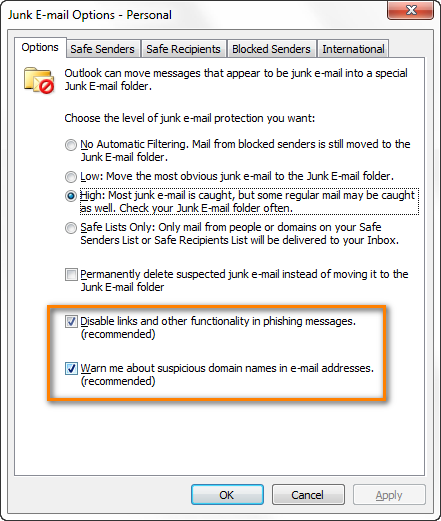
While the last two options seem to be very reasonable and safe precautions that cannot harm you in any way, I would rather not enable the first option to Permanently delete suspected junk email. The point is that even good messages may occasionally get to the Junk mail folder (especially if you opted for the High protection level) and if you choose to permanently delete suspected junk messages, then you won’t have any chance to find and recover a message mistakenly treated as junk. So, you’d better leave this option unchecked and periodically look through the Junk e-mail folder.
prevent good emails from being treated as junk (safe senders and safe recipients lists)
The next two tabs of the spam options dialogs allow you to add email addresses or domain names to the sender lists and safe recipients. Email messages from either of these two lists will never be considered spam, regardless of their content.
safe recipient list. If your email account is set up to receive mail only from trusted senders and you don’t want to miss a single message sent to this email address, you can add such a address (or domain) to your list of safe recipients. if you are on some mailing/distribution lists, you can also add a distribution list name to your safe recipients.
To add someone to your safe list, simply click the Add button in the right-hand part of the window and type an e-mail address or domain name.
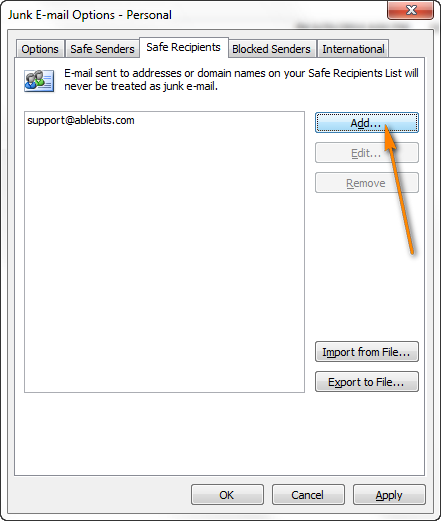
Another way to add a contact to your Safe list is to right click a message, click Junk and choose one of the options: Never Block Sender’s Domain, Never Block Sender or Never Block this Group or Mailing List.
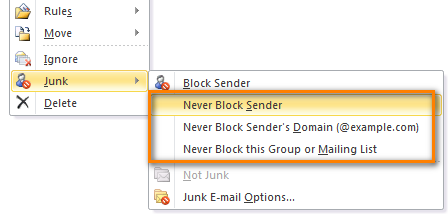
To have trusted contacts automatically added to your safe senders list, you can check two additional options found at the bottom of the safe senders tab:
- also trust email from my contacts
- automatically add people I email to the safe senders list

You can also import Safe Senders and Safe Recipients from a .txt file by clicking the Import from File… button located in the right-hand part of the dialog window.
why the blocked senders list is not the best way to stop spam
The blocked senders list is the opposite of the two safe lists we just discussed. all messages arriving from individual email addresses or domains on this list will be considered spam and automatically moved to the spam folder, regardless of their content. At first glance, adding spam senders to the block list seems like the most obvious way to opt out of spam, but it actually has very little effect and here’s why:
- firstly, because spammers don’t usually use the same email addresses twice and adding each address to the blocked senders list is just a waste of time.
- secondly Instead, if you have an exchange based account outlook, the blocked senders list and two safe lists are stored on the exchange server which allows you to store up to 1024 addresses on these lists combined. When your lists reach this limit, you will get the following error message: “An error occurred while processing your spam list. You have exceeded the size limit allowed on the server.”
- and on Third, when receiving email, the first thing Outlook does is check incoming messages against spam filter lists. As you will understand, the shorter your lists are, the faster the incoming email will be processed.
“This is Okay, but what shall I do if I am being bombarded with thousands of junk emails?” you may ask. If all those spam messages come from a certain domain name, then of course, you shall add it to the Blocked Senders list. However, instead of right-clicking an email and choosing Junk > Block Sender from the pop-up menu as most people do, block the entire domain using the Junk E-mail Options dialog. At that, there is no need to enter sub-domains or use wild characters such as an asterisk (*). You can ban the entire domain by simply entering @some-spam-domain.com and stop all junk mail coming from that domain.
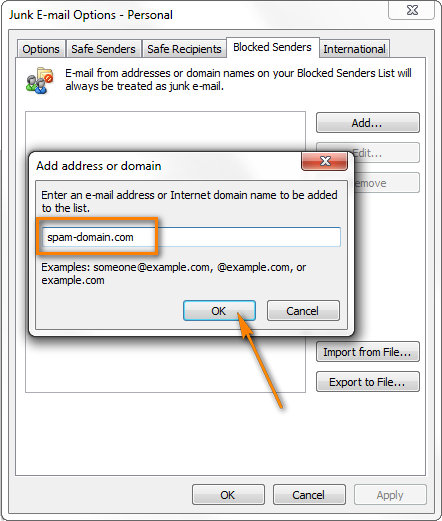
If you do need to block a particularly annoying spammer, you can simply right-click the message and choose Junk > Block Sender from the context menu.
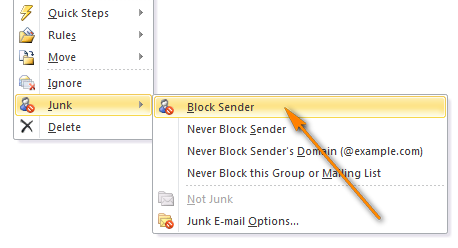
block spam in foreign languages or from specific countries
If you want to stop receiving emails in foreign languages you don’t know, switch to the last tab of the spam options dialog, international tab. This tab offers the following two options:
Blocked Top-Level Domains List. This list lets you block email messages from specific countries or regions. For example, if you select CN (China) or IN (India), then you will stop receiving any messages if a sender’s address that ends with .cn or .in.
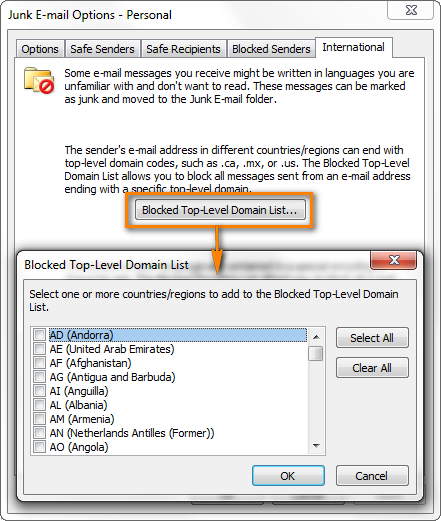
However, nowadays, when almost everyone has gmail or outlook.com accounts, this option will hardly help you to get rid of a lot of spam. and this brings us to the second option which looks much more promising.
Blocked Encodings List. This list enables you to eliminate all unwanted e-mail messages formatted in a specific language encoding, i.e. displayed in a language that you don’t understand and cannot read anyway.
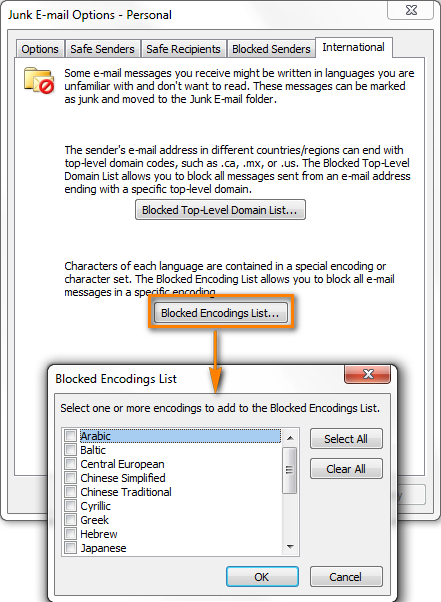
how to keep your spam filter up to date
Most spam is obvious and easily recognizable. However, there are some very sophisticated spammers who diligently research Microsoft’s spam filter technology, obtain the factors that cause an email to be treated as spam, and continually improve their spam strategies. On the other hand, Microsoft goes to great lengths to fight the latest spam techniques and adjusts the spam filter accordingly to reduce spam in your inbox. therefore it definitely makes sense to always have the latest version of the spam filter in outlook.
The easiest way is to turn automatic Windows updates on. You can verify if this option is enabled on your computer by going to the Control Panel > Windows Update > Change settings. Under Important updates, choose the options right for you.

As you can see in the screenshot above, my preference is “check for updates but let me choose whether to download and install them”. under recommended updates, you can select “give me recommended updates the same way I receive important updates”. Please note that you must have administrator rights to be able to change the update options.
Alternatively, you can always download the latest version of Outlook Junk Email Filter for Outlook 2003, 2007, 2010, 2013 and 2016 from the Microsoft website.
how to report spam to microsoft to improve the spam filter
If even the latest version of the spam filter doesn’t catch all the spam that comes into your inbox, then you can report those messages to microsoft to help them improve the effectiveness of your email not wanted. filtering technologies.
You can do this using the Spam Reporting Add-on for Outlook, download links for Outlook 2003, 2007, 2010, 2013 and 2016 32-bit and 64-bit are available here. go through the installation process by simply clicking next, next, finish and after restarting outlook you will find a new option “report junk” added to your junk filter.
You can now report spam directly to Microsoft in the following ways:
- Select a junk message in the list of emails and click Report Junk on the Outlook ribbon (Home > Junk > Report Junk)
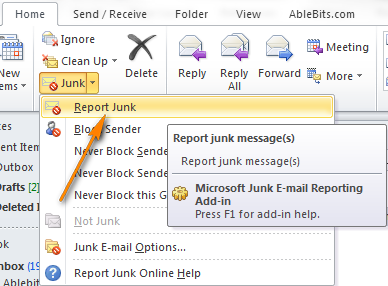
If you have already opened a junk e-mail, proceed in the same way.
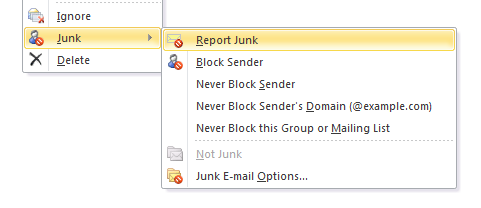
how to remove legitimate email from spam folder
As mentioned at the beginning of this article, even good, legitimate emails can occasionally be treated as spam and moved to the spam folder. no one is perfect in this world, and neither is the spam filter 🙂 so remember to check your spam folder from time to time. how often you do this is up to you. If you set your filter to high to stop as many spam messages as possible, it’s a good idea to check it often. I check it at the end of my work day to make sure I’ve covered everything.
If you spot a legitimate message among junk emails, you can right click it and choose Junk > Not Junk from the context menu.
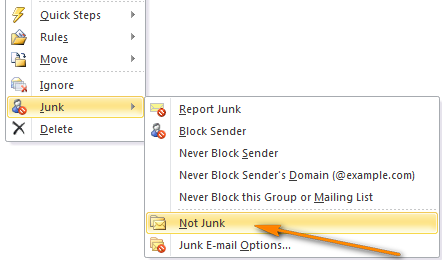
Clicking Not Junk will move the message to your Inbox and provides you the option to Always trust e-mail from that e-mail address. It you select this check box, the sender’s address will be added to your Safe Senders list, and the junk filter won’t make the same mistake again.

If you prefer not to add a particular sender to your safe list, you can simply drag a message that was misidentified as junk to any other folder with your mouse.
how to turn off spam filtering
If important messages that you think should be in your inbox often end up in your spam folder, you can try modifying your spam filter settings as explained earlier in this article. If this doesn’t help and you’re still not happy with how the spam filter treats your email, then you can turn it off and use other methods to stop spam e.g. third-party tools or services.
In order to turn the Microsoft Outlook’s Junk filter off, go to Home > Junk > Junk E-mail Options… > Options tab, select No Automatic Filtering and click OK.
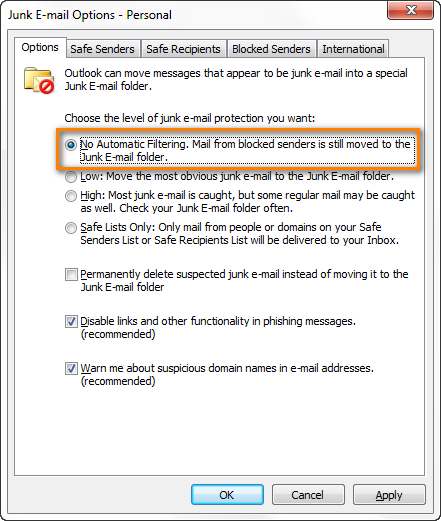
If you want to disable automatic filtering entirely, you can do so in two ways:
- Clean your Blocked Senders list. In the Junk E-mail Options dialog window, navigate to the Blocked Senders tab, select all the addresses and click the Remove button.
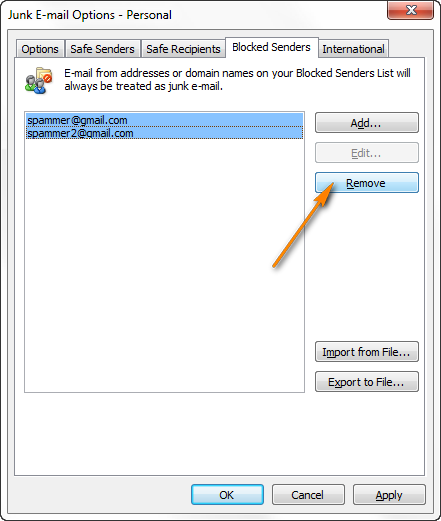
- If you think you might need the Blocked Senders list at some point in the future, then you can disable the Junk email filter in the registry.
- Open the registry (click the Start button and type regedit).
- Browse to the following registry key in Outlook 2010: HKEY_CURRENT_USERSoftwarePoliciesMicrosoftoffice14.0outlook If you have Outlook 2013 installed, then the version number will be 15.0 instead of 14.0; for Outlook 2007 it will be 12.0.
- Right click anywhere within the right-hand pane, add the DisableAntiSpam DWORD and set it to 1 (Value 1 disables the junk filter, 0 enables it).
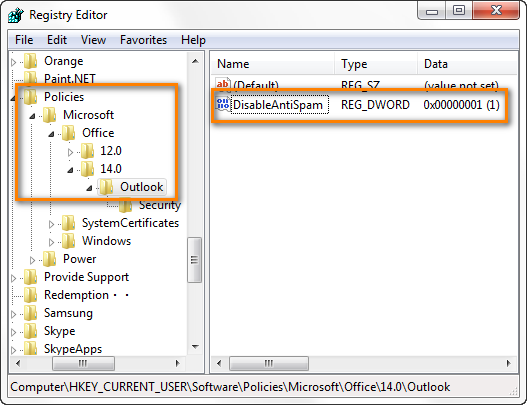
this way you will have the junk filter completely disabled, including the list of blocked senders. the spam button on the outlook ribbon will also be disabled and grayed out.
and this seems to be all for today. a lot of information, but I hope it’s useful and helps you get rid of all those nasty spam emails in your inbox, or at least reduce their number. just remember that all filters, even the most powerful ones, have some false positive results. so just make it a rule to periodically check your spam folder to make sure you don’t miss any important messages. thanks for reading!
you may also be interested
- how to back up outlook emails and other items
- how to archive in outlook automatically or manually
- how to get a delivery receipt in outlook
- how to view outlook email headers (internet headers)
